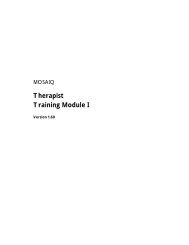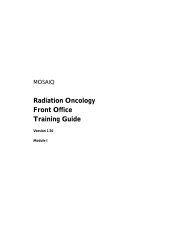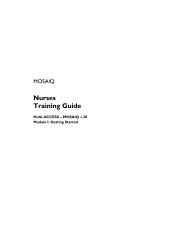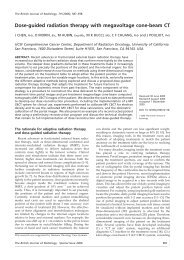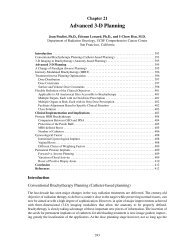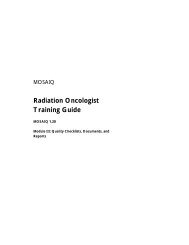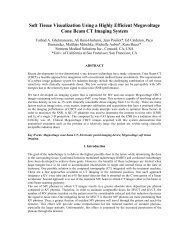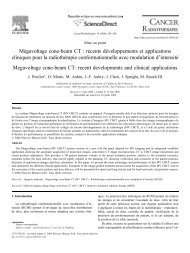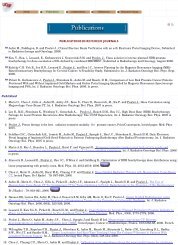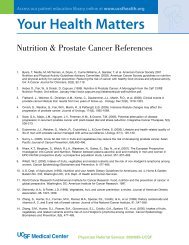IB Senior Educational Objectives - UCSF Radiation Oncology
IB Senior Educational Objectives - UCSF Radiation Oncology
IB Senior Educational Objectives - UCSF Radiation Oncology
You also want an ePaper? Increase the reach of your titles
YUMPU automatically turns print PDFs into web optimized ePapers that Google loves.
Rev. 9/14/10<br />
<strong>UCSF</strong> DEPARTMENT OF RADIATION ONCOLOGY<br />
EDUCATIONAL OBJECTIVES FOR SENIOR RESIDENTS IN NEURO-ONCOLOGY<br />
Igor J. Barani, M.D.<br />
PATIENT CARE<br />
In addition to the guidelines listed by the ACGME, senior resident must be able to provide<br />
compassionate, appropriate, and effective treatment for patients. They must promote health<br />
maintenance both during and after treatment. For each cancer patient, senior residents will be<br />
expected to:<br />
1. Communicate effectively and demonstrate respectful behavior when interacting with<br />
the patient and her family/caregivers.<br />
2. Gather essential and accurate information about the patient from the review of all<br />
pertinent medical records and diagnostic tests, both within the <strong>UCSF</strong> medical<br />
system as well as appropriate outside health care facilities (as necessary).<br />
3. Gather pertinent information from the patient through interview history and physical<br />
examination.<br />
4. Counsel and educate patients and their families.<br />
5. Develop and carry out management plans.<br />
6. Select the appropriate technique and competently perform the procedures with<br />
increased proficiency that are considered essential for the radiotherapeutic<br />
management and follow-up of neuro-oncology patients and encountered on the<br />
service, including:<br />
a. External beam radiation therapy (IMRT, 3D-CRT) for definitive treatment of<br />
CNS tumors.<br />
b. External beam radiation therapy (IMRT, 3D-CRT) for palliative treatment of<br />
CNS tumors.<br />
c. Stereotactic radiosurgery (or radiotherapy) treatment techniques (e.g. Gamma<br />
Knife, Cyberknife, or linear accelerator-based techniques) for definitive and<br />
palliative treatment of various CNS conditions (benign and malignant)<br />
d. CNS brachytherapy for recurrent disease.<br />
e. Evaluate differential and cumulative dose-volume histograms (DVHs) for normal<br />
and tumor tissues.<br />
This process will include knowledge of all aspects of the simulation and treatment planning process,<br />
including delineation and design of treatment fields, selection of photon/electron energy, beam<br />
modifiers, radiotherapy dose and fractionation, identification an outline of tumor and critical organs<br />
on MR and CT scans for the purpose of treatment planning, evaluation of treatment plans, and<br />
evaluation of port films.<br />
MEDICAL KNOWLEDGE<br />
<strong>Senior</strong> residents will be expected to have a more in-depth knowledge of the following with an<br />
increased emphasis on evidence-based medicine and knowledge of the pertinent literature:<br />
1. Learn basic (and advanced) neuroanatomy, with an emphasis on axial imaging (e.g.<br />
CT and MR imaging) as well as plain film radiography (use of bony landmarks to<br />
localize lesions/radiotherapy targets).<br />
2. Demonstrate familiarity with imaging modalities routinely used in neuro-oncology,<br />
particularly MR imaging and various pulse-sequences used for treatment planning<br />
(e.g. time-of-flight imaging for AVMs, SPGR sequences etc.)<br />
1
Rev. 9/14/10<br />
3. Demonstrate proficiency in neurological examination as well as a basic physical<br />
exam. Learn to recognize neurologic syndromes which reflect the lesion(s), and<br />
the subsequent evolution of these signs/symptoms during the course of<br />
therapy/disease.<br />
4. Understand the epidemiology, anatomy, and natural history, and pathophysiology of<br />
various CNS tumors (both benign and malignant; primary and metastatic)<br />
5. Be familiar with the role of molecular markers and gene expression profiles as<br />
predictive and prognostic markers for disease recurrence and response to<br />
treatment.<br />
6. Know the classification of various CNS tumors (benign and malignant), including<br />
grading of benign conditions such as arterio-venous malformations (AVMs).<br />
7. Demonstrate knowledge base of factors that influence treatment decisions (clinical,<br />
pathologic, and biologic)<br />
8. Discuss management of primary and metastatic brain and spine tumors, including<br />
indications for surgery and systemic therapy , and these modalities are integrated<br />
with radiation therapy.<br />
9. The junior and senior residents are expected to using the linear-quadratic (LQ)<br />
model to predict acute and late toxicity, adjust fractionation schemes, and convert<br />
between different fractionation schemes.<br />
10. Demonstrate familiarity with acute and long-term side effects of radiation and their<br />
management; for conventionally-fractionated or hypofractionated treatments as<br />
well as radiosurgery (e.g. Gamma knife)<br />
11. Know radiation safety principles, particularly with respect to use of sealed sources.<br />
PRACTICE-BASED LEARNING and IMPROVEMENT<br />
Residents must demonstrate the ability to use information technology and feedback to improve their<br />
fund of knowledge and skills. The expectation is that they learn how search, review, and analyze<br />
medical information in PubMed as well as the <strong>UCSF</strong> Medical Library.<br />
INTERPERSONAL and COMMUNICATION SKILLS<br />
All residents are expected to:<br />
1. Communicate with patient and their family/caregivers in an easily understood and<br />
culturally sensitive manner.<br />
2. Communicate effectively with medical and support staff, demonstrating respect and<br />
maintaining professional relationships with all members of the radiation oncology<br />
team.<br />
3. Communicate with other physicians and health care professionals.<br />
4. Work effectively as a team member, progressively accepting more responsibility and<br />
participate in a leadership role as progressing through the residency.<br />
5. Maintain comprehensive, accurate and timely medical records. All relevant medical<br />
records must be completed within 48 hours of the patient visit.<br />
PROFESSIONALISM<br />
All residents are expected to:<br />
1. Demonstrate compassion, respect, and integrity and responsiveness to patient's<br />
needs.<br />
2. Be accountable to their patients and their profession.<br />
2
Rev. 9/14/10<br />
3. Be responsive to the needs of the referring/primary healthcare team; completing<br />
patient-care tasks in a timely and responsible manner (especially in the inpatient<br />
setting) so as not to delay or impede patient’s further care or discharge from the<br />
hospital.<br />
4. Demonstrate a commitment to excellence and on-going professional development.<br />
5. Function well as a member of the team.<br />
6. Practice in an ethical manner with regard to provision or withholding of care,<br />
confidentiality of PHI, and informed consent.<br />
7. Maintain comprehensive, accurate, and timely medical records.<br />
8. Function as role models and mentors for junior residents.<br />
SYSTEM-BASED PRACTICE<br />
<strong>Senior</strong> residents will demonstrate an awareness of and responsiveness to the health care system and<br />
ability to call on resources to provide care. They are expected to:<br />
1. Understand how their professional patient care practices affect other health care<br />
professionals, the healthcare organization and the community.<br />
2. Practice cost-effective health care that does not compromise quality of care.<br />
3. Advocate for quality patient care practices and help patients navigate through<br />
complexities in the healthcare system.<br />
4. Be able to partner with healthcare managers and providers to access, coordinate, and<br />
improve health care; be aware of how these activities affect system performance.<br />
LIST OF SPECIFIC EXPECTATIONS<br />
The following is a list of specific expectations for resident physicians in training at <strong>UCSF</strong> while<br />
assigned to the Neuro-<strong>Oncology</strong> Service In <strong>Radiation</strong> <strong>Oncology</strong>. The goal of the list is to facilitate<br />
learning, improve patient management skills, and to improve knowledge of relevant literature and its<br />
application to the individual patient.<br />
1. Be prepared to discuss relevant literature with attending physician(s). Literature<br />
should be reviewed in advance of patient presentation to the attending physician.<br />
The reference reading list will be located on the department server and many<br />
seminal articles which apply to the daily practice will be provided on the server in<br />
the PDF format. Additional reading recommendations will be made by the<br />
attending physician as indicated.<br />
2. Attend relevant CNS conferences:<br />
a. Pediatric and Adult Neuro-<strong>Oncology</strong> Conference (Thursday, 12:30 – 2:30 pm,<br />
weekly)<br />
b. Radiosurgery Conference (Thursday, 2:30 – 3:30 pm, weekly); starts immediately<br />
after the Neuro-<strong>Oncology</strong> Conference<br />
c. Skull Base Conference (Thursday, 3:30 – 4:30 pm, first week of every month)<br />
d. Spine Tumor Conference (Wednesday, 7:30 – 8:30 am, third week of every month)<br />
e. CNS Chart Rounds (Wednesday, 8:00 – 9:00 am, weekly)<br />
3. Check and sign port films with the attending for on-treatment patients weekly.<br />
4. Gamma knife: Participate in the simulation, planning, and treatment delivery of<br />
radiosurgical procedures. The residents are expected to remain in the Gamma<br />
knife control area for the entire duration of the patient’s procedure. They are also<br />
responsible for helping the attending physician position the patient for treatment<br />
and then for helping to remove head frame post-treatment. They are also<br />
expected to assist the attending physician with providing patients post-treatment<br />
3
Rev. 9/14/10<br />
care instructions (including any required prescriptions etc.). The residents are also<br />
expected to participate in the management of acute and late toxicities of therapy.<br />
5. CyberKnife: Participate in the simulation, planning, and treatment delivery. They<br />
must accompany the attending physician to verify treatment setup of the first<br />
treatment fraction (if multiple treatment fractions are given). They are also<br />
expected to assist the attending physician with providing patients post-treatment<br />
care instructions (including any required prescriptions etc.). The residents are also<br />
expected to participate in the management of acute and late toxicities of therapy.<br />
6. Brain Brachytherapy: The resident is responsible for actively participating in the<br />
procedure, accompanying attending physician to the operating theatre, assisting in<br />
the seed placement, documenting and observing relevant safety protocols,<br />
providing patient and family members with post-implant instructions.<br />
7. Read/Study<br />
A list of relevant reference articles will be located on the department server for<br />
resident download.<br />
8. Maintain service list of patients (current, past, and pending) and continue to update<br />
the list to ensure adequate follow-up of pending patient care items.<br />
9. Neurocognitive Clinic (Tuesdays)<br />
a. On Tuesday of every week (pending a clinic change), the residents are expected to be<br />
in the clinic with Dr. Caroline Racine (in-house neuropsychologist) to learn and<br />
observe how to take a cognitive history and how to administer cognitive screening<br />
exam (MOCA). They will also be expected to learn the basic brain-behavior<br />
relationships and effects of intervention on neuropsychological test results.<br />
b. The residents will be supervised on this day by Dr. Racine and are responsible for<br />
completing any reading or tasks assigned.<br />
10. New Patients<br />
a. Obtain records and prepare for patient prior to their arrival. Present case to<br />
attending as indicated. Identify clinical issues and questions raised by a specific case.<br />
Make recommendations for patient’s care based on evidence found in literature. Cite<br />
relevant literature in summary write-up. Discuss relevant literature with attending.<br />
b. Devise and review treatment plan based on patient indications and planning.<br />
c. Follow-up on pending surgeries, pathology, medical records, imaging, and other<br />
relevant clinical patient information.<br />
d. Attend all simulation visits; order relevant simulation studies.<br />
e. Be prepared to discuss risks and benefits of radiation therapy with patients when<br />
requested by the attending physician.<br />
f. Attend all new patient starts and review port films at the treatment machine.<br />
g. In treatment planning, the resident is responsible for contouring the following tumor<br />
and normal tissue structures:<br />
i. Cranial Cases:<br />
1. Tumor (or surgical cavity); GTV, CTV, and PTV (as indicated)<br />
2. Bilateral Eyes<br />
3. Bilateral Optic Nerves<br />
4. Chiasm<br />
5. Bilateral Cochlea and Vestibular Apparatus<br />
6. Pituitary Gland<br />
7. Hypothalamus<br />
8. Bilateral Temporal Lobes<br />
4
Rev. 9/14/10<br />
9. Brainstem (from the cerebral peduncles to the foramen magnum)<br />
10. Bilateral Parotids<br />
11. Spinal Cord (from the foramen magnum to C2)<br />
ii. Spine Cases:<br />
1. Tumor (or surgical bed); GTV, CTV, and PTV (as indicated)<br />
2. Spinal cord (two vertebral body levels above and below the target)<br />
3. Relevant, treatment-level specific surrounding normal tissue<br />
structures (e.g. small or large bowel, heart, lungs, thyroid, etc.)<br />
h. Calculate dose-volume histograms, both differential and cumulative, and understand<br />
the relevant thresholds.<br />
i. Become familiar with management of acute and late radiation reactions (e.g. radiation<br />
necrosis)<br />
j. Document in Lantis (or equivalent department medical record system) the following:<br />
i. Date of initial diagnosis<br />
ii. Date of consultation<br />
iii. Treatment site (ICD-9 code)<br />
iv. Tumor stage/grade information<br />
v. Histology<br />
vi. Simulation note, describing simulation position, immobilization devices, type<br />
of simulation (PET, CT, MR, or fluoroscopy), specific scan instructions (e.g.<br />
scan slice thickness, gap, +/- contrast etc.)<br />
vii. Treatment site, modality, energy, dose/fractionation<br />
viii. Notify medical physicist(s) if specific pre-treatment checks (e.g. TLDs) are<br />
required<br />
11. On-Treatment Patients<br />
i. Be aware of issues and status during treatment.<br />
ii. Maintain on-treatment list of patients; document on-treatment issues in<br />
Lantis (or equivalent electronic medical record system); notify attending of<br />
any patient-specific issues/complications<br />
iii. Check weekly port films with attending physician; respond to therapist<br />
inquiries regarding patient care issues<br />
12. Follow-up Patients<br />
i. See follow-up patients with attending physician; document follow-up visits in<br />
a clear, concise manner, and communicate with relevant services to ensure<br />
proper management and follow-up of patients (e.g. ensure follow-up visits<br />
with medical oncology for systemic therapy etc.)<br />
ii. Obtain recent test results, imaging and clinical notes on patients in advance<br />
of appointments and review with attending; this includes relevant medical<br />
records from outside medical facilities.<br />
13. Understand machine- and patient-specific QA practices for external beam<br />
treatments.<br />
14. Obtain training in emergency procedures of each treatment modality used (e.g.<br />
Gamma knife, Cyberknife, linear accelerator, and brachytherapy) and document<br />
proficiency.<br />
15. Final Examination (supervised)<br />
<strong>Senior</strong> resident is responsible for overseeing and leading the consultation,<br />
simulation, planning, plan evaluation, and treatment delivery of a definitive CNS<br />
treatment case (e.g. glioma, meningioma, etc.). The resident will be evaluated on<br />
5
Rev. 9/14/10<br />
the adequacy of treatment (target coverage, dose, fractionation) and safety<br />
(observing well-established dose-volume critical structure thresholds). The<br />
resident will be closely supervised throughout the process by the attending<br />
physician, but will be responsible for presenting and justifying the entire treatment<br />
plan, including decision to treat using any available supporting evidence. It is<br />
possible to fail the examination by exceeding normal tissue thresholds in the<br />
absence of proper justification, causing potential harm to the patient, or by undertreating<br />
the tumor.<br />
6




